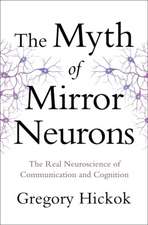Multimodal Oscillation-based Connectivity Theory
Editat de Satu Palvaen Limba Engleză Paperback – 31 mai 2018
Systems-level neuronal mechanisms that coordinate the temporally, anatomically, and functionally distributed neuronal activity into coherent cognitive operations in the human brain have remained poorly understood. In humans, neuronal oscillations and synchronization can be recorded non-invasively with electro- and magnetoencephalography (EEG and MEG) that have excellent temporal resolution and an adequate spatial resolution when combined with source-reconstruction methods. In this book, leading authors in the field describe how recent methodological advances have paved the way to several major breakthroughs in the observations of large-scale synchrony from human non-invasive MEG data.
This volume also presents the caveats influencing analyses of synchronization. These include the non-homogeneous sensitivity of MEG to superficial cortical sources, and, most importantly, the multitude of consequences of linear mixing. Linear mixing is an immense confounder in the sensor-level analyses of synchronization, but is also present at the source level. Approaches that can be used to avoid or compensate for these issues are then discussed.
Thereafter, several authors take up a number of the functional roles that large-scale synchronization has in cognition. The authors assess how the spatio–temporal and –spectral organization and strength of both local and large-scale synchronized networks are associated with conscious sensory perception, visual working memory functions, and attention. These chapters summarize several lines of research showing how the strength of local and inter-areal oscillations in both cortical and subcortical brain structures is correlated with cognitive functions. Together these data suggest that synchronized neuronal oscillations may be a systems-level neuronal mechanism underlying the coordination of distributed processing in human cognition. In line with this argument, other authors go on to describe how oscillations and synchronization are altered in clinical populations, complementing the data presented on healthy subjects.
Importantly, this book includes chapters from authors using many different approaches to the analyses of neuronal oscillations, ranging from local oscillatory activities to the usage of graph theoretical tools in the analyses of synchronization. In this way the present volume provides a comprehensive view on the analyses and functional significance of neuronal oscillations in humans. This book is aimed at doctoral and post-doctoral students as well as research scientists in the fields of cognitive neuroscience, psychology, medicine, and neurosciences.
| Toate formatele și edițiile | Preț | Express |
|---|---|---|
| Paperback (1) | 633.53 lei 6-8 săpt. | |
| Springer International Publishing – 31 mai 2018 | 633.53 lei 6-8 săpt. | |
| Hardback (1) | 643.16 lei 6-8 săpt. | |
| Springer International Publishing – 15 iun 2016 | 643.16 lei 6-8 săpt. |
Preț: 633.53 lei
Preț vechi: 745.32 lei
-15% Nou
Puncte Express: 950
Preț estimativ în valută:
121.22€ • 126.57$ • 100.33£
121.22€ • 126.57$ • 100.33£
Carte tipărită la comandă
Livrare economică 04-18 aprilie
Preluare comenzi: 021 569.72.76
Specificații
ISBN-13: 9783319812373
ISBN-10: 3319812378
Ilustrații: VII, 147 p. 30 illus., 28 illus. in color.
Dimensiuni: 155 x 235 mm
Greutate: 0.23 kg
Ediția:Softcover reprint of the original 1st ed. 2016
Editura: Springer International Publishing
Colecția Springer
Locul publicării:Cham, Switzerland
ISBN-10: 3319812378
Ilustrații: VII, 147 p. 30 illus., 28 illus. in color.
Dimensiuni: 155 x 235 mm
Greutate: 0.23 kg
Ediția:Softcover reprint of the original 1st ed. 2016
Editura: Springer International Publishing
Colecția Springer
Locul publicării:Cham, Switzerland
Cuprins
Challenges in the analyses of large-scale synchronization from human MEG recordings.- Dynamical network states as predisposition of perception.- Neuronal synchronization, attention orienting, and primary consciousness.- The role of neuronal synchronization in visual working memory.- Thalamo-cortical communication and neural oscillations in large-scale network.- Neurocognitive decoding of aesthetic appreciation.- Neuromagnetic network synchronization in development and its alterations in clinical child populations.- Organization of functional networks in neurological and psychiatric diseases.
Notă biografică
Satu Palva, PhD Docent in Neuroscience, Project Leader (Cognitive Neuroscience)University of HelsinkiHer self-profile for the "Satu Palva group" in Cognitive Neuroscience at U. Helsinki Human cognition is serial, introspectively coherent, and has a limited capacity of few objects. Yet, the underlying neuronal processing is anatomically, spectrally, and temporally distributed. The neuronal mechanisms that underlie the binding of this scattered processing into unified attention, memory, and consciousness are poorly understood. Oscillatory synchronization may function as such a mechanism and underlie the coordination and binding of distributed neuronal activity. Our aim is to test this hypothesis by using magneto- and electroencephalography (M/EEG), MRI and fMRI. We are particularly interested in the neuronal mechanisms of attention, working memory, and consciousness. Specifically we address the functional significances of synchronization and multi band oscillations in these cognitive functions and the putative role of cross-frequency interactions as a mechanism for the integration of spectrally and temporally distributed processing. We also investigate what changes cortical oscillations and synchronization undergo during developmental and experience-dependent plasticity and their functional role in neuropsychiatric diseases.
Textul de pe ultima copertă
Systems-level neuronal mechanisms that coordinate the temporally, anatomically, and functionally distributed neuronal activity into coherent cognitive operations in the human brain have remained poorly understood. In humans, neuronal oscillations and synchronization can be recorded non-invasively with electro- and magnetoencephalography (EEG and MEG) that have excellent temporal resolution and an adequate spatial resolution when combined with source-reconstruction methods. In this book, leading authors in the field describe how recent methodological advances have paved the way to several major breakthroughs in the observations of large-scale synchrony from human non-invasive MEG data.
This volume also presents the caveats influencing analyses of synchronization. These include the non-homogeneous sensitivity of MEG to superficial cortical sources, and, most importantly, the multitude of consequences of linear mixing. Linear mixing is an immense confounder in the sensor-level analyses of synchronization, but is also present at the source level. Approaches that can be used to avoid or compensate for these issues are then discussed.
Thereafter, several authors take up a number of the functional roles that large-scale synchronization has in cognition. The authors assess how the spatio–temporal and –spectral organization and strength of both local and large-scale synchronized networks are associated with conscious sensory perception, visual working memory functions, and attention. These chapters summarize several lines of research showing how the strength of local and inter-areal oscillations in both cortical and subcortical brain structures is correlated with cognitive functions. Together these data suggest that synchronized neuronal oscillations may be a systems-level neuronal mechanism underlying the coordination of distributed processing in human cognition. In line with this argument, other authors go on to describe how oscillations and synchronization are altered in clinical populations, complementing the data presented on healthy subjects.
Importantly, this book includes chapters from authors using many different approaches to the analyses of neuronal oscillations, ranging from local oscillatory activities to the usage of graph theoretical tools in the analyses of synchronization. In this way the present volume provides a comprehensive view on the analyses and functional significance of neuronal oscillations in humans. This book is aimed at doctoral and post-doctoral students as well as research scientists in the fields of cognitive neuroscience, psychology, medicine, and neurosciences.
This volume also presents the caveats influencing analyses of synchronization. These include the non-homogeneous sensitivity of MEG to superficial cortical sources, and, most importantly, the multitude of consequences of linear mixing. Linear mixing is an immense confounder in the sensor-level analyses of synchronization, but is also present at the source level. Approaches that can be used to avoid or compensate for these issues are then discussed.
Thereafter, several authors take up a number of the functional roles that large-scale synchronization has in cognition. The authors assess how the spatio–temporal and –spectral organization and strength of both local and large-scale synchronized networks are associated with conscious sensory perception, visual working memory functions, and attention. These chapters summarize several lines of research showing how the strength of local and inter-areal oscillations in both cortical and subcortical brain structures is correlated with cognitive functions. Together these data suggest that synchronized neuronal oscillations may be a systems-level neuronal mechanism underlying the coordination of distributed processing in human cognition. In line with this argument, other authors go on to describe how oscillations and synchronization are altered in clinical populations, complementing the data presented on healthy subjects.
Importantly, this book includes chapters from authors using many different approaches to the analyses of neuronal oscillations, ranging from local oscillatory activities to the usage of graph theoretical tools in the analyses of synchronization. In this way the present volume provides a comprehensive view on the analyses and functional significance of neuronal oscillations in humans. This book is aimed at doctoral and post-doctoral students as well as research scientists in the fields of cognitive neuroscience, psychology, medicine, and neurosciences.
Caracteristici
Describes how recent technical advances have resulted in several major breakthroughs in the analyses and observations of large-scale synchrony from human non-invasive MEG data Shows power of large-scale synchronization in predicting conscious sensory perception and in coordinating visual working memory functions and attention Provides evidence that synchronized neuronal oscillations are the systems-level neuronal mechanism underlying coordination of distributed processing in human cognition













